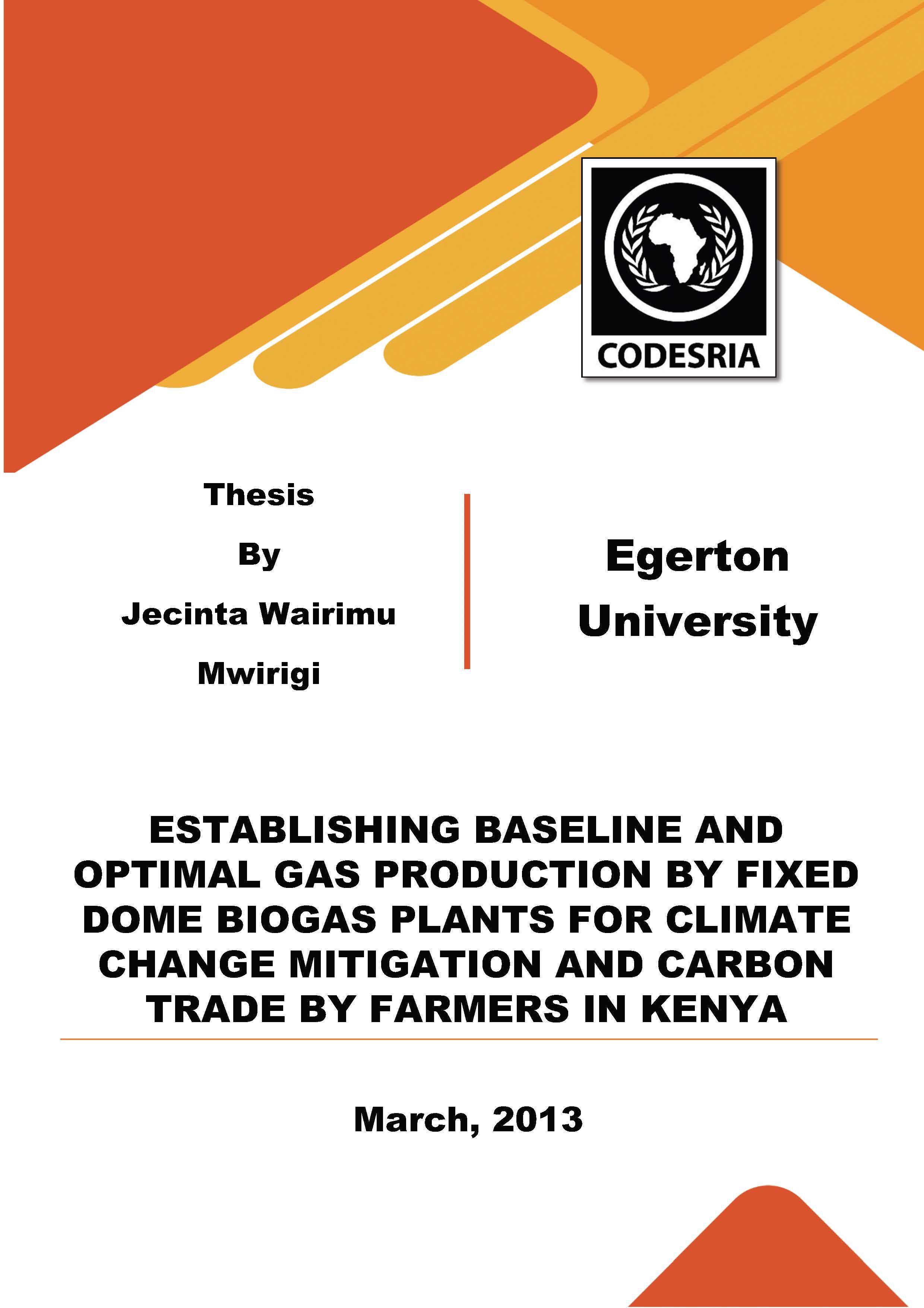ESTABLISHING BASELINE AND OPTIMAL GAS PRODUCTION BY FIXED DOME BIOGAS PLANTS FOR CLIMATE CHANGE MITIGATION AND CARBON TRADE BY FARMERS IN KENYA
Synopsis
While carbon dioxide (CO2) from industrial and transport activities pose a global warming and climate change challenge to the developed countries, methane from agricultural/livestock production practices might have a similar effect in the developing
countries. Therefore, there is a need for profitable emission reduction measures for methane, such as the carbon trade. Baseline emissions as well as proof that the planned emission reductions would not occur without the additional incentive provided by emission reductions credits, a concept known as "additionality", are a prerequisite for carbon trade through the
Clean Development Mechanism (CDM). The current study, therefore, is aimed at measuring gas production by the various sizes of fixed dome biogas plants in the Bahati area as a way of establishing the baseline information. It also examined the effect of 7 variables on gas production with the aim of optimizing gas production from the same plants. These factors include the size of the plant and the number of cattle owned by the household (HH). The study employed the case study research design method with a target population of 63 functional fixed dome biogas plants in the Bahati area. Quantative data was generated and
analyzed through descriptive and inferential statistics. The study showed that the current biogas plants are too large for the available waste and that it is possible to reduce the sizes of majority of the plants (98%) that were between 8 and 16m3 to smaller sizes of 2 to 6 m3 without affecting the amount of gas they produce. To come up with these sizes, the study established a formula Z=0.6Y where Z is the size of the digester, 0.6 is a constant and Y is the number of cattle owned by a HH. Since it is not cost effective to reduce the size of the current plants, it was concluded that this research will be of use to upcoming biogas units. The study recommends a new concept to “additionality” which will be achieved through use of the formula in estimating the digester sizes that will efficiently accommodate all available dung. Small plant sizes coupled with the financial assistance from CDM will make the plants affordable to the majority of farmers. This would lead to proliferation of digesters that are
effective in climate change mitigation.
Downloads
References
Ellis, J., Winkler, H., Corfee-Morlot, J. and Gagnon-Lebrum, F.(2007). CDM: Taking stock and looking forward. Energy Policy 36(3):929-936
ETC.(2007). Biogas for better life: An African initiative . Available from: http://www.biogasafrica.org/index.php?option=com_docman&task=doc_download&gid=17. [Accessed September 20, 2008 at 6.30pm].
FAO.(2006). Livestock impacts on the environment. Available from: http://www.fao.org/ag/magazine/0612sp1.htm [Accessed April 28, 2009 at 7.00pm].
Freedom House. (2008). Freedom in the world 2008. Washington, DC: Freedom House
Fulford, D. (1988). Running a biogas program: A handbook. London: Intermediate technology publication.
GOK(2010). 2009 population & housing Census results. Population distribution by sex, number of households, area, density and administrative units. Nairobi, GPO
Green Markets International. (2007). The Voluntary Carbon Market: Status & potential to advance sustainable energy activities. Available from: http://www.greenmarkets.org/Downloads/vCarbon.pdf [Accessed May 5, 2009 at 2pm].
Gtz (n.d.). Biogas Digest Volume I: Biogas Basics . Available from: http://www.gtz.de/de/dokumente/en-biogas-volume1.pdf [Accessed March 10, 2012 at 2.30pm].
Gupta, J., van Beukering,P., van der Gaast, W. and de jong, F.(2008).Clean and sustainable? An evaluation of the contribution of the clean development mechanism to sustainable development in host countries. IOB Evaluations. Policy and Evaluation Department no.310, April 2008. The Hague, The Netherlands: Policy and Operation Department.
Hankins, M. (1989). Renewable energy in Kenya. Nairobi: Mortif Creative Arts Ltd.
Hashimoto, A.G., Varel, V. H. and Chen, Y. R.(1981). Ultimate methane yield from beef cattle manure. Effects of temperature, ration constituents, antibiotics and manure age.
Agricultural wastes 3:241-256
Hawn, A. (2005). Horses for courses- Voluntary vs. CDM carbon projects in Mexico. The ecosystems marketplace. Available from: http://www.ecosystem market.com
Hyera, T. M. (2008). CDM business opportunities in Tanzania. Available from: http://www.cd4cdm.org/sub-Saharan%20Africa/Tanzania/Workshop%20&%20Briefing/CDMbusiness
OportunitiesTanzania_Hyera.pdf [Accessed May 25, 2009 at 1am].






